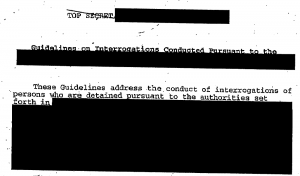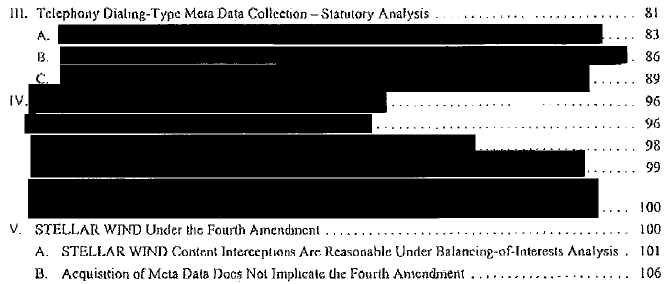The Dragnet Donald Trump Will Wield Is Not Just the Section 215 One
I’ve been eagerly anticipating the moment Rick Perlstein uses his historical work on Nixon to analyze Trump. Today, he doesn’t disappoint, calling Trump more paranoid than Nixon, warning of what Trump will do with the powerful surveillance machine laying ready for his use.
Revenge is a narcotic, and Trump of all people will be in need of a regular, ongoing fix. Ordering his people to abuse the surveillance state to harass and destroy his enemies will offer the quickest and most satisfying kick he can get. The tragedy, as James Madison could have told us, is that the good stuff is now lying around everywhere, just waiting for the next aspiring dictator to cop.
But along the way, Perlstein presents a bizarre picture of what happened to the Section 215 phone dragnet under Barack Obama.
That’s not to say that Obama hasn’t abused his powers: Just ask the journalists at the Associated Press whose phone records were subpoenaed by the Justice Department. But had he wanted to go further in spying on his enemies, there are few checks in place to stop him. In the very first ruling on the National Security Administration’s sweeping collection of “bulk metadata,” federal judge Richard Leon blasted the surveillance as downright Orwellian. “I cannot imagine a more ‘indiscriminate’ and ‘arbitrary’ invasion than this collection and retention of personal data,” he ruled. “Surely, such a program infringes on ‘that degree of privacy’ that the founders enshrined in the Fourth Amendment.”
But the judge’s outrage did nothing to stop the surveillance: In 2015, an appeals court remanded the case back to district court, and the NSA’s massive surveillance apparatus—soon to be under the command of President Trump—remains fully operational. The potential of the system, as former NSA official William Binney has described it, is nothing short of “turnkey totalitarianism.”
There are several things wrong with this.
First, neither Richard Leon nor any other judge has reviewed the NSA’s “sweeping collection of ‘bulk metadata.'” What Leon reviewed — in Larry Klayman’s lawsuit challenging the collection of phone metadata authorized by Section 215 revealed by Edward Snowden — was just a small fraction of NSA’s dragnet. In 2013, the collection of phone metadata authorized by Section 215 collected domestic and international phone records from domestic producers, but even there, Verizon had found a way to exclude collection of its cell records.
But NSA collected phone records — indeed, many of the very same phone records, as they collected a great deal of international records — overseas as well. In addition, NSA collected a great deal of Internet metadata records, as well as financial and anything else records. Basically, anything the NSA can collect “overseas” (which is interpreted liberally) it does, and because of the way modern communications works, those records include a significant portion of the metadata of Americans’ everyday communications.
It is important for people to understand that the focus on Section 215 was an artificial creation, a limited hangout, an absolutely brilliant strategy (well done, Bob Litt, who has now moved off to retirement) to get activists to focus on one small part of the dragnet that had limitations anyway and NSA had already considered amending. It succeeded in pre-empting a discussion of just what the full dragnet entailed.
Assessments of whether Edward Snowden is a traitor or a saint always miss this, when they say they’d be happy if Snowden had just exposed the Section 215 program. Snowden didn’t want the focus to be on just that little corner of the dragnet. He wanted to expose the full dragnet, but Litt and others succeeded in pretending the Section 215 dragnet was the dragnet, and also pretending that Snowden’s other disclosures weren’t just as intrusive on Americans.
Anyway, another place where Perlstein is wrong is in suggesting there was just one Appeals Court decision. The far more important one is the authorized by Gerard Lynch in the Second Circuit, which ruled that Section 215 was not lawfully authorized. It was a far more modest decision, as it did not reach constitutional questions. But Lynch better understood that the principle involved more than phone records; what really scared him was the mixing of financial records with phone records, which is actually what the dragnet really is.
That ruling, on top of better understanding the import of dragnets, is important because it is one of the things that led to the passage of USA Freedom Act, a law that, contrary to Perlstein’s claim, did change the phone dragnet, both for good and ill.
The USA Freedom Act, by imposing limitations on how broadly dragnet orders (for communications but not for financial and other dragnets) can be targeted, adds a check at the beginning of the process. It means only people 2 degrees away from a terrorism suspect will be collected under this program (even while the NSA continues to collect in bulk under EO 12333). So the government will have in its possession far fewer phone records collected under Section 215 (but it will still suck in massive amounts of phone records via EO 12333, including massive amounts of Americans’ records).
All that said, Section 215 now draws from a larger collection of records. It now includes the Verizon cell records not included under the old Section 215 dragnet, as well as some universe of metadata records deemed to be fair game under a loose definition of “phone company.” At a minimum, it probably includes iMessage, WhatsApp, and Skype metadata, but I would bet the government is trying to get Signal and other messaging metadata (note, Signal metadata cannot be collected retroactively; it’s unclear whether it can be collected with standing daily prospective orders). This means the Section 215 collection will be more effective in finding all the people who are 2 degrees from a target (because it will include any communications that exist solely in Verizon cell or iMessage networks, as well as whatever other metadata they’re collecting). But it also means far more innocent people will be impacted.
To understand why that’s important, it’s important to understand what purpose all this metadata collection serves.
It was never the case that the collection of metadata, however intrusive, was the end goal of the process. Sure, identifying someone’s communications shows when you’ve been to an abortion clinic or when you’re conducting an affair.
But the dragnet (the one that includes limited Section 215 collection and EO 12333 collection limited only by technology, not law) actually serves two other primary purposes.
The first is to enable the creation of dossiers with the click of a few keys. Because the NSA is sitting on so much metadata — not just phone records, but Internet, financial, travel, location, and other data — it can put together a snapshot of your life as soon as they begin to correlate all the identifiers that make up your identity. One advantage of the new kind of collection under USAF, I suspect, is it will draw from the more certain correlations you give to your communications providers, rather than relying more heavily on algorithmic analysis of bulk data. Facebook knows with certainty what email address and phone number tie to your Facebook account, whereas the NSA’s algorithms only guess that with (this is an educated guess) ~95+% accuracy.
This creation of dossiers is the same kind of analysis Facebook does, but instead of selling you plane tickets the goal is government scrutiny of your life.
The Section 215 orders long included explicit permission to subject identifiers found via 2-degree collection to all the analytical tools of the NSA. That means, for any person — complicit or innocent — identified via Section 215, the NSA can start to glue together the pieces of dossier it already has in its possession. While not an exact analogue, you might think of collection under Section 215 as a nomination to be on the equivalent of J Edgar Hoover’s old subversives list. Only, poor J Edgar mostly kept his list on index cards. Now, the list of those the government wants to have a network analysis and dossier on is kept in massive server farms and compiled using supercomputers.
Note, the Section 215 collection is still limited to terrorism suspects — that was an important win in the USA Freedom fight — but the EO 12333 collection, with whatever limits on nominating US persons, is not. Plus, it will be trivial for Trump to expand the definition of terrorist; the groundwork is already being laid to do so with Black Lives Matter.
The other purpose of the dragnet is to identify which content the NSA will invest the time and energy into reading. Most content collected is not read in real time. But Americans’ communications with a terrorism suspect will probably be, because of the concern that those Americans might be plotting a domestic plot. The same is almost certainly true of, say, Chinese-Americans conversing with scientists in China, because of a concern they might be trading US secrets. Likewise it is almost certainly true of Iranian-Americans talking with government officials, because of a concern they might be dealing in nuclear dual use items. The choice to prioritize Americans makes sense from a national security perspective, but it also means certain kinds of people — Muslim immigrants, Chinese-Americans, Iranian-Americans — will be far more likely to have their communications read without a warrant than whitebread America, even if those whitebread Americans have ties to (say) NeoNazi groups.
Of course, none of this undermines Perlstein’s ultimate categorization, as voiced by Bill Binney, who created this system only to see the privacy protections he believed necessary get wiped away: the dragnet — both that authorized by USAF and that governed by EO 12333 — creates the structure for turnkey totalitarianism, especially as more and more data becomes available to NSA under EO 12333 collection rules.
But it is important to understand Obama’s history with this dragnet. Because while Obama did tweak the dragnet, two facts about it remain. First, while there are more protections built in on the domestic collection authorized by Section 215, that came with an expansion of the universe of people that will be affected by it, which must have the effect of “nominating” more people to be on this late day “Subversives” list.
Obama also, in PPD-28, “limited” bulk collection to a series of purposes. That sounds nice, but the purposes are so broad, they would permit bulk collection in any area of the world, and once you’ve collected in bulk, it is trivial to then call up that data under a more broad foreign intelligence purpose. In any case, Trump will almost certainly disavow PPD-28.
Which makes Perlstein’s larger point all the more sobering. J Edgar and Richard Nixon were out of control. But the dragnet Trump will inherit is far more powerful.


